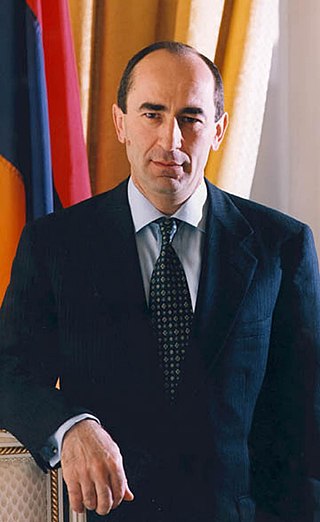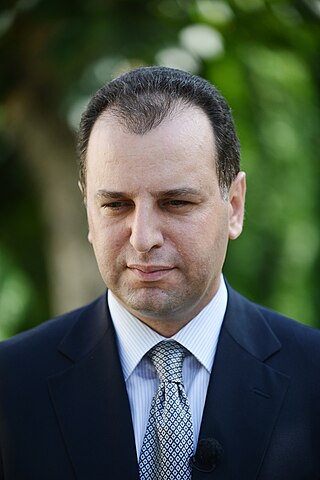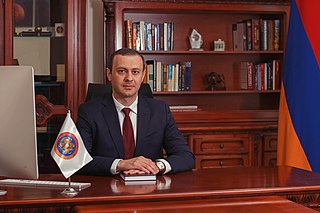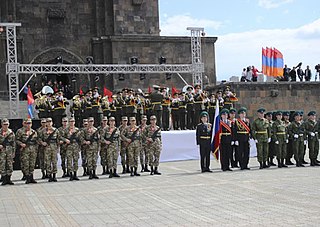
The Government of the Republic of Armenia or the executive branch of the Armenian government is an executive council of government ministers in Armenia. It is one of the three main governmental branches of Armenia and is headed by the Prime Minister of Armenia.

Vazgen Zaveni Sargsyan was an Armenian military commander and politician. He was the first Defence Minister of Armenia from 1991 to 1992 and then from 1995 to 1999. He served as Armenia's Prime Minister from 11 June 1999 until his assassination on 27 October of that year. He rose to prominence during the mass movement for the unification of Nagorno-Karabakh with Armenia in the late 1980s and led Armenian volunteer groups during the early clashes with Azerbaijani forces. Appointed defence minister by President Levon Ter-Petrosyan soon after Armenia's independence from the Soviet Union in late 1991, Sargsyan became the most prominent commander of Armenian forces during the First Nagorno-Karabakh War. In different positions, he regulated the military operations in the war area until 1994, when a ceasefire was reached ending the war with Armenian forces controlling almost all of Nagorno-Karabakh and seven surrounding districts.

Robert Sedraki Kocharyan is an Armenian politician. He served as the President of the Nagorno-Karabakh Republic from 1994 to 1997 and Prime Minister of Nagorno-Karabakh from 1992 to 1994. He served as the second President of Armenia between 1998 and 2008 and as Prime Minister of Armenia from 1997 to 1998.

The Republican Party of Armenia is a national-conservative political party in Armenia led by the third president of Armenia, Serzh Sargsyan.

The prime minister of Armenia is the head of government and most senior minister within the Armenian government, and is required by the constitution to "determine the main directions of policy of the Government, manage the activities of the Government and coordinate the work of the members of the Government." Also, according to the constitution, the prime minister heads the Security Council, which prescribes the main directions of the country's defense policy; thus, the prime minister is effectively the commander-in-chief of the Armed Forces of Armenia. Nikol Pashinyan is the current prime minister. He took the office on 8 May 2018 following the resignation of Serzh Sargsyan.

Levon Hakobi Ter-Petrosyan, also known by his initials LTP, is an Armenian politician and historian who served as the first president of Armenia from 1991 until his resignation in 1998.

Serzh Azati Sargsyan is an Armenian politician who served as the third President of Armenia from 2008 to 2018, and twice as the Prime Minister of Armenia from 2007 to 2008 and again from 17 to 23 April 2018, when he was forced to resign in the 2018 Armenian revolution.

Armen Vardani Sarkissian is an Armenian politician, physicist, investor, businessman, and computer scientist who served as the 4th president of Armenia from 2018 to 2022. He also served as Prime Minister of Armenia from 1996 to 1997. He was the first president of post-Soviet Armenia born in former Armenian SSR.

Nikol Vovayi Pashinyan is an Armenian politician serving as the prime minister of Armenia since 8 May 2018.

Civil Contract is a centrist political party in Armenia.

Vigen Sargsyan is an Armenian politician who served as the Defence Minister of Armenia from October 2016 until May 2018 and as the Chief of Presidential Administration from October 2011 to October 2016.
The following lists events that occurred in 2018 in Armenia.

Presidential elections were held in Armenia on 2 March 2018. As a result of the 2015 Armenian constitutional referendum, this was the first time in Armenia's history when the president was elected by the National Assembly instead of popular vote. Another outcome of the referendum was that the newly elected president will perform a ceremonial role as the country is currently transitioning from a semi-presidential system to a parliamentary republic. Incumbent president Serzh Sargsyan was barred by the Constitution of Armenia from running for a third consecutive term. Armen Sarkissian ran unopposed due to no other party nominating a candidate and easily won the election in the first round with 90 electoral votes.

Snap parliamentary elections were held in Armenia on 20 June 2021. The elections had initially been scheduled for 9 December 2023, but were called earlier due to a political crisis following the 2020 Nagorno-Karabakh War and an alleged attempted coup in February 2021.

Armen Valerii Grigoryan is an Armenian politician and political scientist who is currently serving as Secretary of the Security Council of Armenia.

Shushi Liberation Day is a national holiday celebrated in Armenia and formerly in the self-proclaimed Republic of Artsakh. It is commemorated on both 8 and 9 May as a way to celebrate the anniversary of the Capture of Shushi and the Siege of Stepanakert from Azerbaijani forces in 1992. Being both former Soviet republics, the holiday also commemorates the traditional Victory Day celebrations on 9 May, commemorating the surrender of Nazi Germany at the end of the Great Patriotic War in 1945. The holiday serves as the official holiday of the Artsakh Defense Army, which was established on this day.

Onik Viktori Gasparyan is an Armenian Colonel-General who served as the Chief of the General Staff of the Armenian Armed Forces from 8 June 2020 until his dismissal on 10 March 2021. Gasparyan was dismissed after calling for the resignation of Prime Minister Nikol Pashinyan on 25 February 2021 along with more than 40 other high-ranking Armenian military officers.

The premiership of Nikol Pashinyan began on May 8, 2018, when Nikol Pashinyan was elected in a 59–42 vote by the National Assembly of Armenia to be the 16th Prime Minister of Armenia. Following the resignation of Serzh Sargsyan on April 23 due to mass protests in the country, Pashinyan was seen by the demonstrators as the best possible successor that has no ties to the previous government. His nomination was contested by the republican majority during a vote on May 1, but was finally accepted during a second hearing a week later.
The 2021 Armenian political crisis was an alleged military coup attempt by the Armed Forces of Armenia led by the Chief of the General Staff of the Armenian Armed Forces Onik Gasparyan against the government of Armenian Prime Minister Nikol Pashinyan. Pashinyan accused Gasparyan and 40 other high-ranking military officers of attempting a coup after they published a statement calling for Pashinyan's resignation on 25 February 2021.

The Homeland Salvation Movement was an Armenian political alliance, consisting of several opposition political parties, led by Vazgen Manukyan.





















